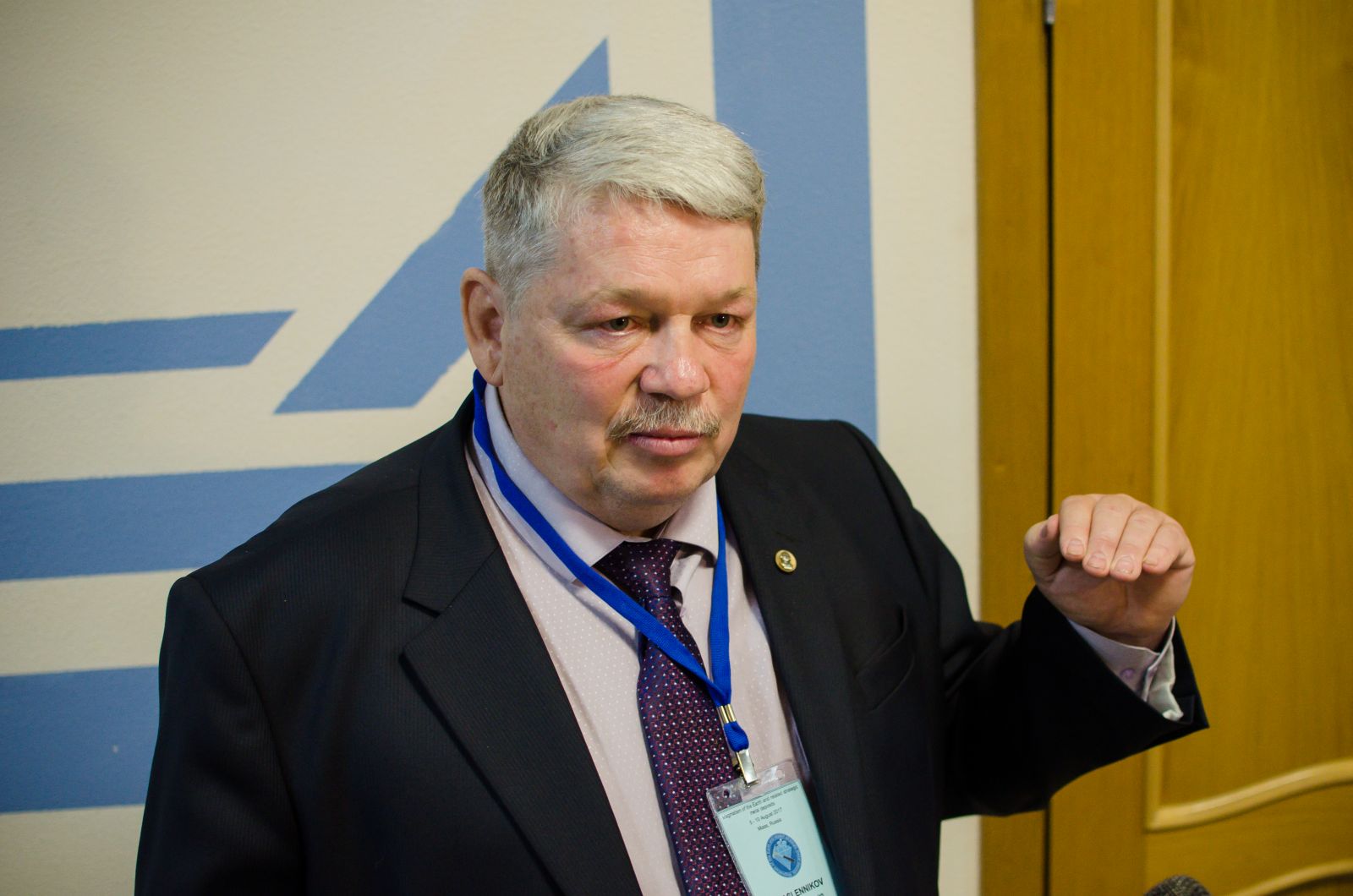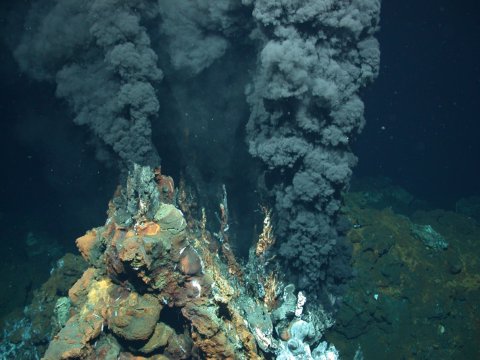The Urals is the largest in the world natural laboratory which contains a large amount of ore deposits. The Ural’s territory is prospected till a certain depth, but the major part of ores lays even deeper in the depths of Earth and excites a great interest for South Ural scientists and the country’s economy in the future. About where the ore-forming “black smokers” dwell in, whether there is similarity in metallogeny of ancient and modern oceans, and how it helps discovering new ore deposits told us Head of the Geology Department of the SUSU Geological Faculty (the Miass branch), Doctor of Geology and Mineralogy, corresponding member of the Russian Academy of Sciences, professor Valeriy Maslennikov.

Valeriy Maslennikov is a laureate of the Russian Federation Government Award in the field of science and technology who was awarded the B. Skinner Award for his work “Establishing scientific foundations for development of ore mineral raw material base of the Urals” and for creating a multistage model of giant gold-ore deposits’ formation, and also the Eureka International Award (Australian Museum Eureka) for reconstructing the history of co-evolution of geochemistry, geotectonic geology, metallogeny and ocean biology from archaea till present days. The results of various research work of the professor are reflected in a series of scientific publications in international journals indexed by the Scopus and Web of Science databases: “Nature”, “Geology”, “Geochimica et Cosmochimica Acta”, “Ore Geology Reviews”, “Economic geology”, etc.
Professor Maslennikov is a versatile researcher who associates himself with natural scientists of the 19thcentury. Well-known in Russian and international scientific environment for more than 30 years, the expert works in different areas at the intersection of geology and biology: geotectonic geology, lithology, mineralogy, geochemistry, palaeoecology, palaeontology, biogeography and biology applicable to ore-forming systems. Being the initiator of complex study of sedimentary ore and circum-ore deposits in the Urals, he was the first one to use the method of compiling facies maps of palaeo-surfaces of pyritiferous hydrothermal sedimentary fields. Applied significance of the scientist’s research is connected with development of criteria for local forecasting of pyritic mineralization.
In the latest decade, the SUSU Geological Faculty and the Institute of Mineralogy of the Ural branch of the RAS held several integration projects including projects of the Federal Target Programs aimed at developing criteria for forecasting of pyritic deposits.
“In particular, we ascertained that metal-rich deposits – the products of oxidation of sulfide sediments and ‘fumes of black smokers’ which we called ‘gossanites’ – were formed on pyritiferous hydrothermal sedimentary fields, explains Valeriy Vladimirovich. It is proved that gossanites differ from ore-free red beds on their mineral and geochemical characteristics, and therefore they can serve as a direct prospecting guide of pyrite presence at a hydrothermal sedimentary field.”
The research engineer does not stop on this achievement and continues developing criteria for forecasting ore deposits in the Urals and make new discoveries in the frameworks of collaboration of SUSU and the Institute of Mineralogy of the Ural branch of the RAS. One of research areas is devoted to comparison of metallogeny of ancient and modern oceans. Metallogeny of paleoceans includes studying location patterns and grasping the reasons for diversity of ore deposits compared to modern analogues.
“We are interested in comparative analysis of ancient ore deposits of the Urals, Rudnyi (Ore) Altai, the Pontides and other metallogenic provinces with modern ore-forming systems of the Pacific and Atlantic oceans. Generally, they are pyrites orebodies, the co-called ‘black smokers’, says professor Maslennikov. During the Paleozoic era, 500-300 million years ago, the Uralian Ocean was covering space much larger than the territory of the modern Urals. Analogues of modern black, grey, white and shimmering smokers were forming in ocean reefs and island-arc basins. In the result of convergence of continents during the Carboniferous period, the Ocean had gone and the Ural Mountains had erected at the spot where continents met. In the zone of ocean closure and submergence of oceanic platform, a part of pyrites orebodies had plunged deep in the depths of Earth, and another part is currently serving as an industrial source of copper, zinc, plumb, gold, silver, tellurium, selenium, bismuth and other useful chemical elements.”
A special spot in the scientist’s research occupy high-temperature “black and grey smokers”. At the bottom of modern oceans in mid-ocean ridges and underwater island arcs there are hydrothermal vents which emanate solutions of black color under pressure at the temperature of 350-400°С. During eruption, the hot solution of “black smokers” (which remind underwater towers) contacts with seawater and forms the metalliferous sulfide sediment and afterwards the perennial ore deposits which nowadays are being mined and concentrated in industrial scale.
“Stocks of some pyrites deposits formed in oceans and buried in the depths of continents are quite comparable. At 32 pyrites deposits which were formed in the interval from archaea (2 bln years) till present days we discovered relicts of hydrothermal funnels of ‘black smokers’. We initially found ‘black smokers’ in the Urals, and then in other regions, for example, in Rudniy Altai (Kazakhstan, Russian Federation), the Pontides (Turkey), the Honshu island (in Japan), the Appalachians (Canada). And it turned out that nowadays the Urals possess the best ‘collection’ in the world! While rare collections of the USA, Turkey and Japan have one-two funnels of paleosmokers, our collection is represented by more than a thousand fragments of ‘funnel fumes’. Each fragment of a funnel, which was formed under high-gradient conditions at temperatures varying from 400 to 2°С, bears the most complete, compared to other types of ores, information about conditions of the deposit formation in general. Using these unique natural records, we learn a lot about specific deposit and pay special attention to deposits whose development is only planned in the future. Thanks to the complex study of hydrothermal funnels we proved that there is a dependency of the composition of minerals, concentrations and a specter of chemical elements of pyrites deposits of ancient and modern oceans on composition of the host rock, geotectonic position and volcanicity modes. This allowed, for example, explaining ore-facial and mineral and geochemical variety of deposits of the pyrites family. Thanks to the new genetic classification, we can forecast specificities of a deposit’s mineral and chemical composition, make predictions about technological value and potential toxicity of ores, and, correspondingly, assess economic and geo-ecologic risks of development and processing of raw material, even before the beginning of the deposit extraction.”
It is exactly here in the Urals that Valeriy Maslennikov and his colleagues made the discovery which was officially acknowledged by scientific community only 20 years later: the most ancient pre-hydrothermal mineralized fauna, which is assumed to belong to the chemosynthesis world, was discovered in ores of pyrites deposits.
“Unlike our sunny world, the world of chemosynthesis is locally flourishing in complete darkness at great depths in modern oceans. Pre-hydrothermal macro-fauna, represented by various tube worms and mollusks, uses chemical energy from oxidation of hydrogen sulphide, methane and hydrogen for synthesizing organic compounds. All this happens at active participation of bacteria which, just like macro-fauna, serve as a food for underwater carnivorous fish and crabs. Despite the toxicity of the medium in zones of hydrothermal ore formations, life had been and still is actively evolving, probably being analogous to the pristine life. Naturally, a question arises: ‘Are we all the modern children of photosynthesis or descendants of the world of chemosynthesis?’ Because the most ancient hydrothermal oases we discovered here, in the Urals, in the early Paleozoic. No one yet found somethingmore ancient. Though such discoveries are possible and expected by us. The result of the last two decades is 6 new types of mineralized pre-hydrothermal fauna discovered by us in ores of the Urals. Pre-hydrothermal fauna is not seen in all modern and ancient pyrites bodies. We determined that the reason for this are differences in concentrations of highly toxic elements such as Tl, Hg, Cd, As and Sb which are delivered into growing and simultaneously oxidizing sulphides. On the contrary, where Se, Co, Ni and Te are concentrated in sulphides, biological productivity of pyritiferous systems is much higher. This is how mineral and geochemical criteria of forecasting paleohydrothermal oases, providing foundation for revealing new biogeography regular patterns, came into existence.”
The accomplished work would be impossible without a symbiosis of science and education, thinks Valeriy Vladimirovich. SUSU and the Institute of Mineralogy of the Ural branch of the RAS have been long and closely cooperating in the field of studying different mineral deposits. Under supervision of the corresponding member of the RAS, senior research scientist of the Institute of Mineralogy of the Ural branch of the RAS, professor of the SUSU Mineralogy Department, a joint “Laboratory of Quartz Raw Material Technology” with modern high-tech equipment has been created. Its purpose is to obtain spectroscopic indicators of high-tech quartz raw material for space industry. Thanks to using the mass-spectrometer with inductively coupled plasma and laser ablation which is situated in the Institute of Mineralogy of the Ural branch of the RAS, lecturers, postgraduates and students of the SUSU Geological Faculty under supervision of V.V. Maslennikov successfully develop the area of “High-tech microelements in minerals” for rational and complex use of natural resources.
“We conduct our research not only in the Urals, but also in the Ilmen Nature reserve. We have global ambitions and a lot of projects on different continents and in the oceans. We try to contribute to fundamental science, and at the same time follow its applied edge remembering about profit for the national economy.”
Science is and will always be useful, considers professor Maslennikov. It is only necessary to constantly deepen your knowledge, get new experience and think ahead.




